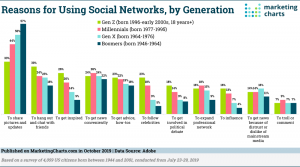
Despite discussions that Twitter is no longer essential for your business, many people still use Twitter to share blogs and other interesting content, as shown in the image below.

The content people share can be the content of YOUR company. However, in order to be shared and enjoy other user engagements, you need to be aware of the proper codes of conduct on Twitter.
This blog lists what you should NOT do if you are using Twitter for business, so you can learn from it and prevent yourself or others working at your company from making mistakes.
1. When using Twitter for business, do NOT make your profile private
As a company, you want your profile to be public. eClincher lists the following reasons why setting your profile to private puts your business at an extreme disadvantage:
- People that are not following you cannot see your profile or tweets
- Your followers can not retweet your posts to increase the reach
- People can tweet to you, but if they are not following you, they cannot see your response
- You have to accept every new follower manually
2. When using Twitter for business, do NOT send automated direct messages
My inbox is always packed with automated direct messages (DMs). Do I read them? No. It just makes me wonder whether you are a human being or a bot.
In fact, automated DMs are the reason why most people avoid their messages on Twitter. Some automation tools will ask you to set up DMs to thank new followers, but you will only scare them away with them. Not only will automated DMs get you unfollowed by the majority of people; they are also a bad first impression for those who do not decide to unfollow you.
If you want to send a DM to new followers, do it manually and make it personal. Also, regularly engage with your target audience, such as retweeting and liking their updates, before reaching out via a DM. Building a relationship beforehand will improve your chances of getting a response.
3. When using Twitter for business, do NOT try to sell all the time
I know you want to share your amazing company with the world, but do not post tweet after tweet promoting your events, discounts, new features, etc. If you did not know it yet, “always be selling” is now “always be helping.” Companies that try to educate people rather than to sell to them are more successful than companies that simply market their products and self-promote.
The key of sales is trust. On social media, this shift has given rise to the phenomenon of trust content, which is explained in the blog “How to Win Hearts with Trust Content.”
4. When using Twitter for business, do NOT send all of your tweets at once
Have you seen this too? Accounts that send 10 tweets in a row. Did you notice how I said accounts? Actions like this make me wonder whether those tweets are sent by bots.
If you are a human being reading this: when you post everything at once, you are missing the majority of your followers. Not everyone is on Twitter 24/7. Spreading your posts throughout the day allows your business to reach different time zones and demographics.
Moreover, as eClincher says, your posts cannibalize each other’s potential engagement: “Instead of receiving retweets and favorites throughout the day, you are forcing followers to choose which posts they like back. It is highly unlikely that someone will engage with several of your posts at once, which is why you should find an ideal posting frequency for your business and stick to it.”
You should not automate your DMs, but scheduling your tweets is definitely a great help for companies.
5. When using Twitter for business, do NOT use too many hashtags
As eClincher explains, hashtags were created to make it easier to find content and conversations about specific topics. When used effectively, hashtags can significantly increase your reach and engagement, while also helping you find new leads.
However, #TooManyHashtagsAreHardToReadAndAnnoying. Reading a hashtag requires extra work, so we need normal text too in order to make sense of your message. If you want to learn more about the correct use of hashtags, the blog “Powerful Hashtagging” explains how you can use hashtags successfully.
6. When using Twitter for business, do NOT forget to be visual
As I said in “14 Easy Things a Company Should NOT Do on Social Media,” visual pieces of content are faster for us to process and are easily sharable. According to Shae Bennett, 90 percent of information transmitted to the brain is visual, and we process images 60,000 times faster than plain text.
By using photos and videos in your campaigns, you can thus dramatically increase user engagement and ROI. If you do not use a photo or video in your posts, your posts will hardly be noticed.
7. When using Twitter for business, do NOT use a trending topic for self-promotion
Many companies have made the mistake of adding the top trending hashtag to a Tweet without researching what the trending topic is about, or by using it in an insensitive way.
Millions were in uproar in 2011 after Kenneth Cole used the Egypt uprising and Cairo hashtag to promote his spring line on Twitter: “Millions are in uproar in #Cairo. Rumor is they heard our new spring collection is now available online at http://bit.ly/KCairo.”
You do not want your company to end up in such a negative discussion, right?
As Dale Davies says, being sensible with trending topics is a must. If the trending topic is a tragedy, any comments must be entirely non-promotional. Davies urges you to use language like “our thoughts are with the families…” and “our sympathies to…”
8. When using Twitter for business, do NOT start a tweet with ‘@,’ unless you are replying to someone
When you start a tweet with ‘@,’ Twitter sees it as a reply. That means only the person tagged and people that follow both you and that person can see the tweet. If this is what you intended, that is just fine.
However, if you meant to reach more people, because you are giving a compliment to an account for instance, you should enter the message first and add the @[name] at the end or somewhere in the middle. All of your followers can now see it.
It is a simple way of boosting your reach, which can be magnified by adding one or two hashtags.
9. When using Twitter for business, do NOT just follow everyone
Davies has noticed that many new Twitter accounts started by businesses fall into the trap of following every account under the sun in the hope that they follow back. Sadly, this Twitter “relationship” that you have with all these accounts does not lead to positive effects.
Being connected to the right kind of Twitter profiles can have a significant effect if handled correctly, Davies says. It can:
- Help boost the account within the Twitter Suggested Users algorithm
- Make it easier to see how the competition is performing
- Show followers the charities and initiatives it supports
- Be used as an indicator of which sources the company supports and recommends
- Following the key influencers from the community and star customers can also go a long way to show potential future followers that the business listens, values, and engages with what their customers are saying.
10. When using Twitter for business, do NOT forget to use a URL shortener
In just 140 characters, you need to state your message, use the best hashtags, add a photo and, most times, include a URL. Using a URL shortener makes it possible to save on characters, and it makes a Tweet look much cleaner and more professional.
11. When using Twitter for business, do NOT recycle tweets
It is tempting to reuse tweets that have already been posted, especially if they have performed well, but please do not do it. I agree with Kristen Vaughn when she says that the whole purpose of Twitter is to offer unique updates, insights, and perspectives to showcase your expertise and to spark conversations with your audience.
She recommends you look back into some of your recent and exceptional tweets and consider repurposing them. Create a custom graphic or provide additional information around the topic.
12. When using Twitter for business, do NOT abandon your account every now and then
Try not to disappear on your followers for days or weeks at a time. Even worse, if it has happened, do not come back with a Twitter spree. Sending out 50 tweets in an hour will not make up for you being gone for the past month, Vaughn clarifies.
As said, scheduling your tweets is a great feature of social media management tools, so make sure to use them, especially when you will be gone for a few days.
13. When using Twitter for business, do NOT ignore questions, comments or concerns.
Not only is engagement with your customers one of the perks of Twitter and other social-media platforms, it is also vital. Lindsay Tjepkema warns that without engagement, customers may feel as if you do not care about their questions, comments or concerns.
Engaging with those comments is a part of your company’s customer service. Use relevant comments as an opportunity to interact with your followers and show them how you address positive and negative situations.
Hopefully, you now recognize the main mistakes you should avoid on Twitter. Make sure that if you have employees handling your corporate Twitter account (or other social-media accounts), they are aware of these potential fails.
One quick question: would you please share my blog? Thanks!
Digital & Social Articles on Business 2 Community(95)







